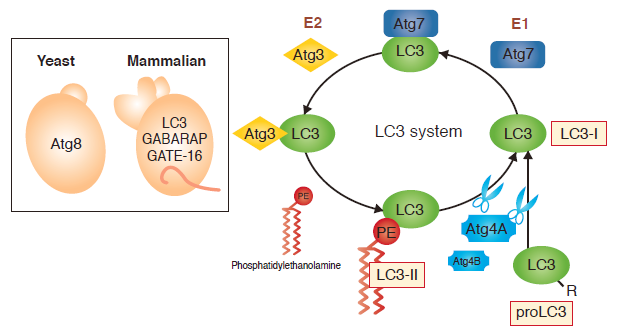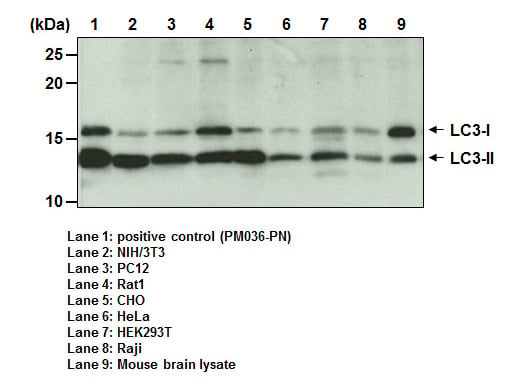LC3 Antibodies
A yeast autophagy-related gene product (Atg8) has three mammalian homologues: LC3, GABAA receptor associated protein (GABARAP), and Golgi-associated ATPase enhancer (GATE-16). Among them, LC3 is most actively studied and frequently used as a mammalian autophagy marker.

Why there are 2 forms of LC3- LC3I and LC3II explained

Microtubule-associated protein 1A/1B-light chain 3 (MAP1LC3) is widely known as its shortened form- LC3, which has a a molecular weight of approximately 17kDa. Shortly after translation (proLC3), LC3 antibodies are processed at the C-terminus by Atg4B or Atg4A into LC3-I. Upon induction of autophagy, LC3-I is conjugated to the substrate phosphatidylethanolamine (PE) via E1 (Atg7) and E2 (Atg3). The PE-LC3-I conjugate is referred to as LC3-II. Despite having a higher molecular weight than LC3-I, LC3-II is more hydrophobic and shows a higher mobility in sodium dodecyl sulfate (SDS)-polyacrylamide gel electrophoresis (SDS-PAGE). In addition, LC3 translocates, where LC3-I is located in the cytosol and LC3-II is found in the membrane.
This shift of LC3-I to LC3-II indicates autophagic activity is occurring. Increased levels of LC3-II indicate autophagosome formation. GABARAP and GATE-16 are also demonstrated to undergo the same process of conjugation with PE. For these reasons, a high quality antibody to detect both forms of LC3 is crucial to understand and analyze the step in the autophagy cycle that is taking place. MBL continues to collaborate with pioneers in autophagy research. We were among the first suppliers for polyclonal and monoclonal antibodies to detect LC3-1 and II.
LC3 has been found to have multiple isoforms. To date, we know of LC3A, LC3B, and LC3C. The protein structures of LC3 A, B and C have been determined and all three isoforms show a conserved region required for autophagosome formation. LC3B is considered to be a popular marker of autophagy. LC3A and LC3B show different expression patterns in rat tissue implicating there may be functional differences. Less is known about LC3C role. The importance and function of each isoform is still under investigation.
MBL offers antibodies that can detect these different isoforms and can be used for visualization/localization studies.
MBL International offers high quality LC3 antibodies specific for detecting exactly the isoform of interest. Our LC3 antibodies can be used for various applications including: western blots, immunohistochemistry, flow cytometry and more.

using product code: M152-3, Anti-LC3 (Human) mAb
| LC3 Antibody | LC3 Isoform | Application | ||||||
|---|---|---|---|---|---|---|---|---|
| MAP1LC3A | MAP1LC3B | MAP1LC3C | WB | FCM | IPP | IHC | ICC | |
| M152 | X | X | X | X | X | X | X | |
| M186 | X | X | ||||||
| PM036 | X | X | X | X | X | X | X | X |
| PD014 | X | X | X | X | ||||
Top anti-LC3 Antibodies:
| Code No. | Product Name | Species Reactivity | Applications |
|---|---|---|---|
| M152-3 | Anti-LC3 (Human) Monoclonal Antibody | Human, Mouse, Rat, Hamster | FCM, ICC, IP, WB |
| M186-3 | Anti-LC3 (Human) Monoclonal Antibody | Human, Mouse, Rat, Hamster | WB |
| M186-7 | Anti-LC3 Monoclonal Antibody-HRP-DirecT | Human, Mouse, Rat, Hamster | WB |
| PD014 | Anti-LC3 (Rat) Polyclonal Antibody | Human, Mouse, Rat, Hamster | WB |
| PM036 | Anti-LC3 (Human) Polyclonal Antibody | Human, Mouse, Rat, Hamster | FCM, ICC, IHC, IP, WB |
White Paper
Dr. Noboru Mizushima provides an in-depth review of autophagy, its current and future perspectives.


